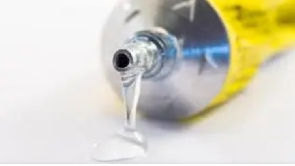Opinions of Monday, 29 May 2023
Columnist: Nunyuie Tv
Chemistry of super glue and its effect on the youth smoker!
This Article is looking at mainly;
1. The chemistry of "glue"
2. Its uses and
3. The toxicity or otherwise of "glue" if there is any.
This is purely paperwork with less laboratory activities.
Caleb Nash Adipah (Author) is a trained scientist with Biology major and chemistry minor background. His main area is Biochemistry. Currently a tutor at a High school in Ghana who teaches Biology and Chemistry.
Glue is any natural or synthetic adhesive, especially a sticky gelatinous substance prepared by boiling animal products such as bones, skin, and horns.
The main ingredient in Super glue is cyanoacrylate *C5H5NO2*. *Cyanoacrylate* is an acrylic resin that cures (forms its strongest bond) almost instantly.
Humans have been using glue for thousands of years, going back to caveman times. Over the years, we have developed an amazing variety of glues, which we use for nearly every purpose.
Why are adhesives sticky?
Adhesives are made of molecules, combinations of atoms that may attract other groups of atoms. It’s sort of like static electricity, but more permanent. Other types of adhesives flow and mix on a surface, and are so thick (or viscous) that they hold things together.
Some glues are sticky polymers dissolved in water or another liquid, like common white glue. As the polymers dry, the liquid evaporates and the solid, sticky adhesive stays behind.
Other glues help things stick because of a chemical reaction.
In silicone and cyanoacrylate glues, such as Krazy Glue and Gorilla Glue, react with water vapor in the air and harden through a chemical reaction.
Because water helps them harden, cyanoacrylates may also be used to close wounds without stitches.
Another example is the Epoxy glue, it has two parts that start the chemical reaction when mixed together. Special epoxy glues used by dentists harden when they are exposed to ultraviolet light. The bonds made by epoxy glues are waterproof and strong. There are so many differences in the kinds of materials you may want to stick together.
One of the main substances in any glue is Toluene.
Toluene, also known as toluol, is a substituted aromatic hydrocarbon. It is a colorless, water-insoluble liquid with the smell associated with paint thinners.
It is a mono-substituted benzene derivative, consisting of a methyl group attached to a phenyl group. As such, its systematic IUPAC name is methylbenzene.
Toluene is typically used in the production of paints, rubber, lacquers, glues and adhesives because it can help dry, dissolve and thin other substances.
Toluene (methylbenzene, toluol, phenylmethane) is an aromatic hydrocarbon (C7 H8) commonly used as an industrial solvent for the manufacturing of paints, chemicals, pharmaceuticals, and rubber.
Toxicity of Toluene
Exposure to toluene can cause eye and nose irritation, tiredness, confusion, euphoria, dizziness, headache, dilated pupils, tears, anxiety, muscle fatigue, insomnia, nerve damage, inflammation of the skin, and liver and kidney damage. Individuals who are exposed to Toluene at all times may be harmed by the aforementioned side effects.
Also, Toluene-2,4-Diisocyanate found in glues if continuously inhaling the smell from glues may cause an asthma-like allergy. Constant exposure can cause asthma attacks with shortness of breath, wheezing, cough, and/or chest tightness.
Repeated high exposure may cause memory and concentration problems.
Toluene-2,4-Diisocyanate can irritate one's lungs.













